Palagems.com Spessartite (Spessartine) Buying Guide
By Richard W. Hughes
Introduction/Name. Garnet is the name for a group of related mineral species. The gem garnets include:
| Pyralspites (aluminum) | Ugrandites (calcium) | ||
| Pyrope | Mg3Al2(SiO4)3 | Uvarovite | Ca3Cr2(SiO4)3 |
| Almandine | Fe3Al2(SiO4)3 | Grossular | Ca3Al2(SiO4)3 |
| Spessartite | Mn3Al2(SiO4)3 | Andradite | Ca3Fe2(SiO4)3 |
In addition to the purer end members mixed garnets such as malaia (or malaya, a pyrope-spessartite) and grandite (a grossular-andradite mixture) exist. The purplish pyrope-almandine mixture is called rhodolite.
The name spessartite (a.k.a. spessartine) is derived from Spessart, in N.W. Bavaria, Germany.
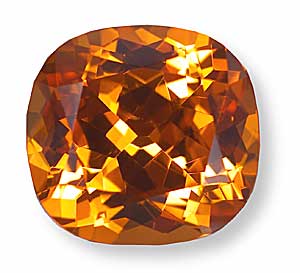 |
| A gorgeous Nigerian spessartite. Photo: Wimon Manorotkul |
Color. Spessartite garnet is ideochromatic, meaning that it is colored by a fundamental element in its composition. That element is manganese, which produces an orange color. Take away the manganese, and it would no longer be spessartite. Thus spessartite has only one basic color – orange.
That said, the color may be modified slightly by mixing with iron, in the form of almandine. This produces a deeper, more reddish coloration.
Spessartites occur in three basic flavors. There are the light and bright stones, which come from Nigeria, Ramona (CA) and the deeper reddish orange stones that also come from Nigeria. Then there are the fabulous tangerine orange “mandarin” garnets from Namibia, which are in a class all by themselves.
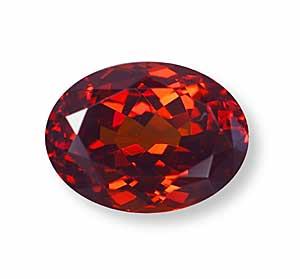 |
| This fine stone is an example of a malaia (pyrope-spessartite) garnet. Photo: Wimon Manorotkul |
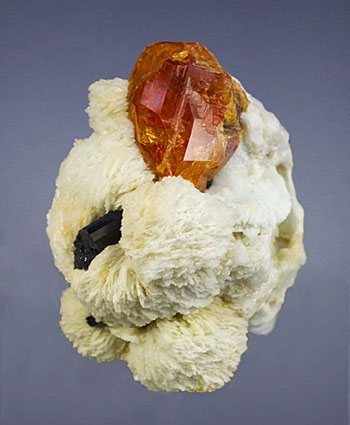 |
| Spessartite with schorl tourmaline and clevelandite from the Little Three mine at Ramona, San Diego County, California. Photo: Wimon Manorotkul |
Lighting. Due to its orange to red-orange color, spessartite generally looks best under incandescent light. When buying any gem, it is always a good idea to examine it under a variety of light sources, to eliminate future surprises.
Clarity. Spessartites from most sources are reasonably clean. Thus eye-clean stones are both desirable and possible. The exception is with the mandarin spessartites from Namibia, which often contain small colorless fibers of tirodite that give the stones a sleepy overall appearance. When only small amounts are present, the effect can be quite beautiful, masking extinction and allowing the beautiful tangerine orange color to shine completely across the entire face of the gem.
 |
| Different levels of clarity are visible here in these spessartite garnets from Nigeria. The oval stone at left is eye clean, i.e., with no clarity defects visible to the unaided eye. In the pear-shaped middle stone, obvious clarity defects are visible, while in the trillion-shaped stone at right, they are even more obvious. Photos: Wimon Manorotkul |
Cut. Spessartites are generally cut similar to other colored stones, with ovals, cushions, trillions and emerald cuts being most common. The lack of pleochroism means that orientation is not a problem and the equidimensional shape of the rough generally provides good yields from rough to cut. Cabochon-cut spessartites are also seen on occasion, particularly with the Namibian mandarin spessartites, which tend to be more heavily included.
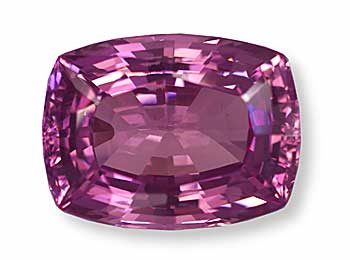 |
| This unusual purple pyrope-spessartite mixed garnet is in the private collection of William Larson. Most pyrope-spessartites, which are also known as malaia garnets) are orange in color. Photo: Wimon Manorotkul |
Prices. The prices of spessartite are, like any gem, dependent on quality. Still, we can make a few generalizations. The flood of Nigerian spessartite took what was once essentially a collector's stone into the realm of jewelry staple. Nigerian spessartites typically retail for $100–250/ct. in the smaller, 1–4 ct. range, while stones of 15–20 cts. may reach as much as $900/ct. at the retail level.
Prices for the rare mandarin spessartites from Namibia are even higher, with smaller goods (1–2 cts.) fetching up to $800/ct. and fine stones above 5 cts. extending well above $1000/ct. The largest fine mandarin garnet seen at Pala was a super 8-ct. stone priced at $2400/ct. retail.
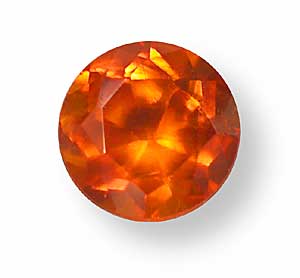 |
| This mandarin spessartite from Namibia shows why this type is the most valuable of all spessartites. Photo: Wimon Manorotkul |
Stone Sizes. While spessartites of greater than 100 cts. cut are known from both Brazil and Madagascar, fine gems of more than 15–20 cts. are rare. For mandarin garnets from Namibia, fine gems of greater than 5 cts. are scarce.
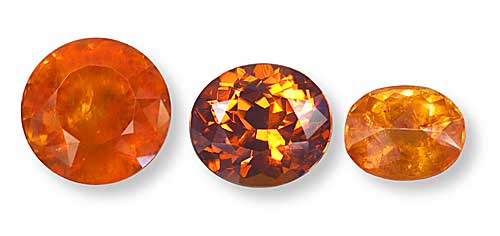 |
| These three gems illustrate the three most important sources of spessartite garnet. From left, a mandarin garnet from Namibia, a spessartite from Nigeria, and a spessartite from the Little Three mine at Ramona, CA. Photos: Wimon Manorotkul |
Sources. Gem spessartite has been found at a number of localities around the world, including Brazil, Burma, Madagascar, Mozambique, Namibia, Nigeria, Sri Lanka and the USA (San Diego County, CA and Amelia Court House, VA). Of these sources, the most important today are Nigeria and northeast Namibia, in the vicinity of the Marienfluss River.
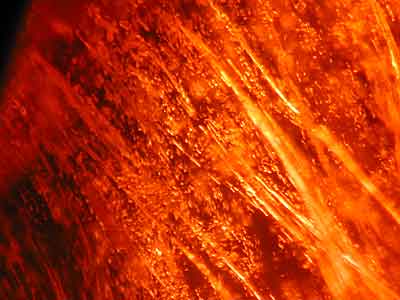 |
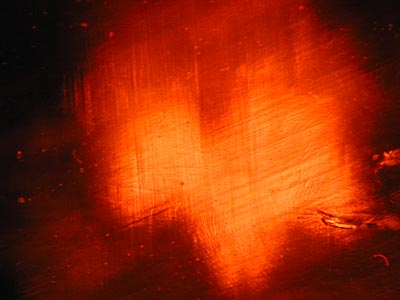 |
| Most mandarin garnets from Namibia have a sleepy appearance. This is due to numerous small crystal and needle inclusions (above). Even in relatively clean stones, graining is often strong (below). Photos: Richard Hughes |
Enhancements. Unlike many colored stones, spessartites are not currently enhanced by any method.
Imitations. Spessartine has never been synthesized, but a number of imitations exist, including natural stones such as hessonite garnet, and man-made imitations such as glass.
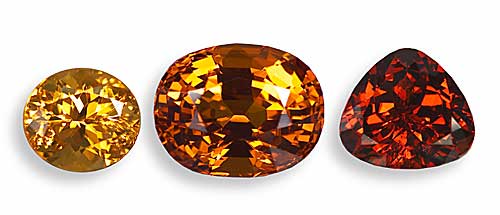 |
| These different flavors of Nigerian spessartite garnet. Most expensive are the rich red-oranges at right, but what is most beautiful is an individual choice. Photos: Wimon Manorotkul |
Properties of Spessartite (Spessartine)
| Composition | Spessartite garnet has the following composition: Mn3Al2(SiO4)3 |
| Hardness (Mohs) | 7 to 7.5 |
| Specific Gravity | 4.15 (+ 0.05; - 0.03) |
| Refractive Index | 1.810 (+ 0.004; - 0.20) |
| Crystal System | Isometric; usually occurs as massive pebbles or dodecahedra/icositetrahedra combinations |
| Colors | Due to its ideochromatic nature, spessartite is always some shade of orange. The color is caused by manganese. |
| Pleochroism | None |
| Dispersion | 0.027 |
| Phenomena | Pyrope-spessartite mixed garnets containing vanadium have been found that display a dramatic green (daylight) to red (incandescent light) change of color. Such stones come from East Africa and Sri Lanka. |
| Handling | Ultrasonic: generally safe, but risky if the gem contains liquid inclusions Steamer: not safe The best way to care for spessartite is to clean it with warm, soapy water. Avoid exposure to heat or acids. |
| Enhancements | None |
| Synthetic available? | No |